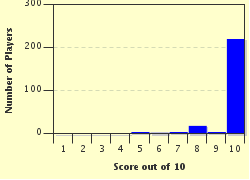
Colors in Spanish, iCaramba! Trivia Quiz
Spanish, spoken by millions, is the most common foreign language learned by 'Anglos' in the USA. Match the English color with the Spanish color (in all CAPS). I'll tell you a little about interesting word origins afterwards. iBuena suerte!
A matching quiz
by gracious1.
Estimated time: 3 mins.
- Home
- »
- Quizzes
- »
- World Trivia
- »
- Languages
- »
- Spanish
